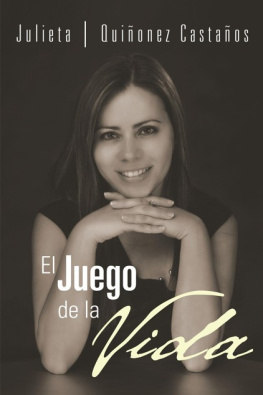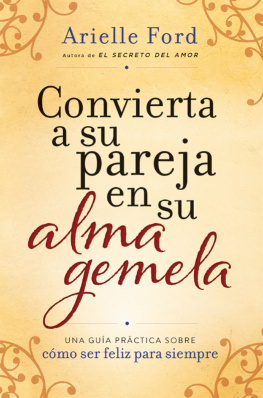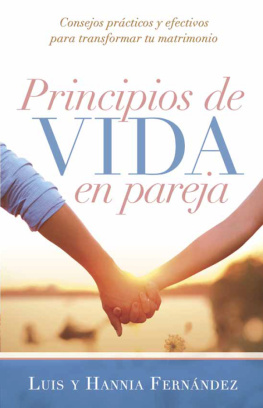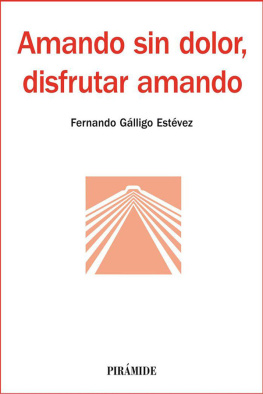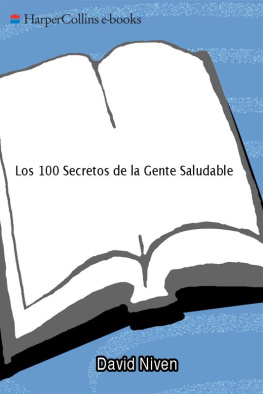Ha sido un placer trabajar con Gideon Weil, con su equipo de HarperSanFrancisco y con Sandy Choron, mi agente. Les agradezco a todos el esfuerzo y el entusiasmo por convertir este libro en una herramienta más útil para los lectores.
Acitelli, L., D. Kenny, y D. Weiner. 2001. “The Importance of Similarity and Understanding of Partners’ Marital Ideals to Relationship Satisfaction” Personal Relationships 8: 167–85.
Allen, S., y P. Webster. 2001. “When Wives Get Sick: Gender Role Attitude, Marital Happiness, and Husbands’ Contribution to Household Labor.” Gender and Society l5: 898–916.
Alvaro, J. 2001. “And Interpersonal Forgiveness and Reconciliation Intervention: The Effect on Marital Intimacy.” Disertación Ph.D., Seminario Teológico Baptista, Nueva Orléans.
Appleton, C., y E. Bohm. 2001. “Partners in Passage: The Experience of Marriage in Mid-Life.” Journal of Phenomenological Psychology 32: 4l-70.
Arriaga, X., y C. Agnew. 2001. “Being Committed: Affective, Cognitive, and Conative Components of Relationship Commitment.” Personality and Social Psychology Bulletin 27: 1190–1203.
Arrindell, W., y F. Luteijn. 2000. “Similarity Between Intimate Partners for Personality Traits as Related to Individual Levels of Satisfaction with Life.” Personality and Individual Differences 28: 629–37.
Bachand, L., y S. Caron. 2001. “Ties That Bind: A Qualitative Study of Happy Long-Term Marriages.” Contemporary Family Therapy 21: 105–21.
Ball, L. 2000. “How Gender Differences Contribute to Divorce: A Retrospective Qualitative Study.” Disertación Ph.D., California School of Professional Psychology.
Barile, C. 2001. “The Never-Married, Caucasian, American Woman in MidLife as a Departure from the Stereotypes of the Old Maid Spinster.” Disertación Ph.D., Pacifica Graduate Institute.
Beach, S., D. Whitaker, D. Jones, y Tesser. 2001. “When Does Performance Feedback Prompt Complementarity in Romantic Relationships?” Personal Relationships 8: 231–48.
Becker, P., y P. Moen. 1999. “Scaling Back: Dual-Earner Couples’ Work-Family Strategies.” Journal of Marriage and the Family 61: 995–1007.
Berry, J., y E. Worthington. 2001. “Forgivingness, Relationship Quality, Stress While Imagining Relationship Events, and Phisycal and Mental Health.” Journal of Counseling Psychology 48: 447–55.
Blair, A. 2001. “Individuation, Love Styles, and Health-Related Quality of Life Among Collage Students.” Disertación Ph.D., Universidad de Florida.
Bonds-Raacke, J., Bearden, N. Carriere, E. Anderson, y S. Nicks. 2001. “Engaging Distortions: Are We Idealizing Marriage?” Journal of Pysichology 135: 179–84.
Bosson, J., y W. Swann. 2001. “The Paradox of the Sincere Chameleon: Strategic Self-Verification in Close Relationships.” In Close Romantic Relationships: Maintenance and Enhancement, editado por J. Harvey y A. Wenzel. Mahwah, NJ: Laurence Erlbaum Associates.
Boyer-Pennington, M., J. Pennington, y C. Spink. 200l. “Students’ Expectations and Optimism Toward Marriage as a Function of Parental Divorce.” Journal of Divorce and Remarriage 34: 71–87.
Broemer, P. 2001. “Ease of Recall Moderates the Impact of Relationship-Related Goals Judgments of Interpersonal Closeness.” Journal of Experimental Social Psychology 37: 261–66.
Brown, S. 2000. “Union Transitions Among Cohabitors: The Significance of Relationship Assessments and Expectations.” Journal of Marriage and the Family 62: 833–46.
Bumpass, L., y J. Sweet. 2001. “Marriage, Divorce, andIntergenerational Relationships.” In The Well-Being of Children and Families, editado por A. Thornton. Ann Arbor: University of Michigan Press.
Burland, A. 2001. “Attachment and Emotion Regulation in Dating Relationships: Exposure and Reactivity to Daily Appraisals of Partner Behavior.” Disertación Ph. D., Universidad de Delawere.
Bush, H., R. Williams, M. Lean, y A. Anderson. 2001. “Body Image and Weight Consciousness Among South Asian, Italian, and General Population Women in Britain.” Appetite 37: 207–15.
Buss, D., T. Shackelford, L. Kirkpatrick, y R. Larsen. 2001. “A Half Century of Mate Preferences: The Cultural Evolution of Values.” Journal of Marriage and the Family 63: 491–503.
Buunk, B., y W. Mutsaers. 1999. “The Nature of the Relationship Between Remarried Individuals and Former Spouses and Its Impact on Marital Satisfaction.” Journal of Family Psychology 13: 165–74.
Campbell, L., J. Simpson, D. Kashy, y W. Rholes. 2001. Attachment Orientations, Dependence, and Behavior in a Stressful Situation: An Application of the Actor-Partner Interdependence Model.” Journal of Social and Personal Relationships 18: 821–43.
Carrere, S., K. Buehlman, J. Gottman, J. Coan, y L. Ruckstuhl. 2000. “Predicting Marital Stability and Divorce in Newlywed Couples.” Journal of Family Psychology 14: 42–58.
Carsten, K. 2001. “Enhancing Satisfaction Through Downward Comparison: The Role of Relational Discontent and Individual Differences in Social Comparison Orientation.” Journal of Experimental Social Psychology 37: 452–67.
Cauffield, C., J. Moye, y L. Travis. 1999. “Long-Term Marital Conflict: Antecedents to and Consequences for Discharge Planning.” Clinical Gerontologist 20: 82–86.
Caughlin, J., y T. Huston. 2002. “A Contextual Analysis of the Association Between Demand/Withdraw and Marital Satisfaction.” Personal Relationships 9: 95–119.
Chou, K., y I. Chi. 2001. “Stressful Life Events and Depressive Symptoms: Social Support and Sense of Control as Mediators or Moderators?” International Journal of Aging and Human Development 52: 155–71
Chements, R., y C. Swensen. 2000 “Commitment to One’s Spouse as a Predictor of Marital Quality Among Older Couples.” Current Psychology 19: 110–19.
Cohan, C., y S. Cole. 2002. “Life Course Transitions and Natural Disaster: Marriage, Birth, and Divorce Following Hurricane Hugo.” Journal of Family Psychology 16: 14–25.
Cole, M. 2000. “The Experience of Never-Married Women in Their Thirties Who Desire Marriage and Children.” Disertación Ph.D., Institute for Clinical Social Work.
Collins, N., y B. Feeney. 2000. “A. Safe Haven: An Attachment Theory Perspective on Support Seeking and Caregiving in Intimate Relationships.” Journal of Personality and Social Psychology 78: 1053–73.
Conway, C. 2000. “Using the Crucial Cs to Explore Gender Roles with Couples. ” Journal of Individual Psychology 56: 495–501.
Cox, D. 2001. “ ‘Smile, Honey, Our Church Is Watching’: Identity and Role Conflict in the Pastoral Marriage.” Disertación Ph.D., University of South Florida.
Davis, J., y C. Rusbult. 2001. “Attitude Alignment in Close Relationships.” Journal of Personality and Social Psychology 81: 65–84.
De Koning, E., y R. Weiss. 2002. “The Relational Humor Inventory: Functions of Humor in Close Relationships.” American Journal of Family Therapy 30: 1–18.
Diener, E., C. Gohn, E. Eunkook, y S. Oishi. 2000. Similarity of the Relations Between Marital Status and Subjetive Well-Being Across Cultures.” Journal of Cross-Cultural Psychology 31: 419–36.
Drigotas, S., C. Rusbult, y J. Verette. 1999. “Level of Commitment, Mutuality of Commitment, and Couple Well-Being.” Personal Relationships 6: 389–409.
Dufore, S. 2000. “Marital Similarity, Marital Interaction, and Couples’ Shared View of Their Marriage.” Disertación Ph.D., Syracuse University.
Dugosh, J. 2001. “Effects of Relationships Threat and Ambiguity on Empathic Accuracy in Dating Couples.” Disertación Ph.D., Universidad de Texas en Arlington.
Ebesu Hubbard, A. 2001. “Conflict Between Relationally Uncertain Romantic Partners: The Influence of Relational Responsiveness and Empathy.” Communication Monographs 68: 400–414.




